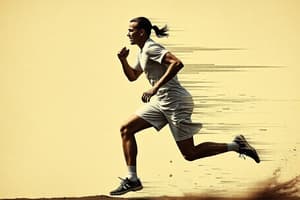Podcast
Questions and Answers
What are the control variables in the reaction time measurement experiment?
What are the control variables in the reaction time measurement experiment?
Working distance between thumb and first finger, ruler measurement at the top of the thumb, and room conditions
Describe the procedure for measuring a person's reaction time in the experiment.
Describe the procedure for measuring a person's reaction time in the experiment.
Person 1 sits on a stool with upright posture and places their dominant arm across the table with their hand hanging over the edge. Person 2 holds a ruler vertically with the zero centimeter mark between person 1's thumb and first finger, then drops it at a random time for person 1 to catch.
What is the dependent variable in the reaction time measurement experiment?
What is the dependent variable in the reaction time measurement experiment?
Reaction time
Explain the concept of the independent variable in the context of this experiment.
Explain the concept of the independent variable in the context of this experiment.
What are some other independent variables that could be investigated in this experiment?
What are some other independent variables that could be investigated in this experiment?
How are the results of the reaction time experiment converted to reaction time?
How are the results of the reaction time experiment converted to reaction time?
Flashcards are hidden until you start studying
Study Notes
- The text describes a method for measuring a person's reaction time in a practical experiment.
- The experiment involves two people: person 1 has their reaction time measured by person 2, then they switch places.
- Person 1 sits on a stool with upright posture and places their dominant arm across the table with their hand hanging over the edge.
- Person 2 holds a ruler vertically with the zero centimeter mark between person 1's thumb and first finger.
- Person 2 tells person 1 to prepare to catch the ruler and drops it at a random time. Person 1 catches the ruler with their thumb and first finger as quickly as possible and the reaction time is recorded.
- The test is repeated several times and a mean is calculated.
- The results can be converted to reaction time using a conversion table.
- The independent variable in the experiment is the person having their reaction time measured, the dependent variable is the reaction time.
- Control variables include keeping the working distance between thumb and first finger constant, measuring the ruler at the top of the thumb, and keeping the conditions in the room the same.
- Other independent variables that could be investigated include the effect of practice, hand dominance, and chemicals such as caffeine.
- To investigate the effect of caffeine, the test subject would consume a measured amount of Cola half an hour before the experiment.
- Controls include checking for medical issues that could be affected by caffeine and conducting the test in a lab without hazardous chemicals.
- Questions about the required practical can be found in the teacher's vision workbook.
Studying That Suits You
Use AI to generate personalized quizzes and flashcards to suit your learning preferences.




